Are you curious about the dragon’s architectural representation during the Ly and Tran dynasties in Vietnam? SIXT.VN is here to guide you through the intricate world of Vietnamese dragon symbology, its historical roots, and cultural significance. Understanding these influences will give you a deep appreciation for Vietnam’s artistry, allowing you to explore the beauty and cultural richness of the S-shaped country with confidence.
1. What Architectural Style Does the Vietnamese Dragon Symbol Represent? (Ly/Tran Dynasty?)
The Vietnamese dragon symbol, particularly during the Ly (11th-13th centuries) and Tran (13th-15th centuries) dynasties, represents a unique blend of architectural styles characterized by elegance, dynamism, and a strong connection to Vietnamese identity. The Ly Dynasty dragons are known for their flowing, serpentine forms that represent enlightenment and prosperity, while the Tran Dynasty dragons exhibit a more robust and powerful image symbolizing military strength and resilience.
1.1. The Ly Dynasty (11th-13th Centuries): Elegance and Prosperity
During the Ly Dynasty, the architectural style emphasized grace and sophistication. Dragons were depicted with smooth, elongated bodies, flowing lines, and intricate details, reflecting a sense of peace and prosperity. The dragon motifs were often integrated into state symbols, clothing, and architectural designs, signifying the dynasty’s commitment to enlightenment and cultural refinement.
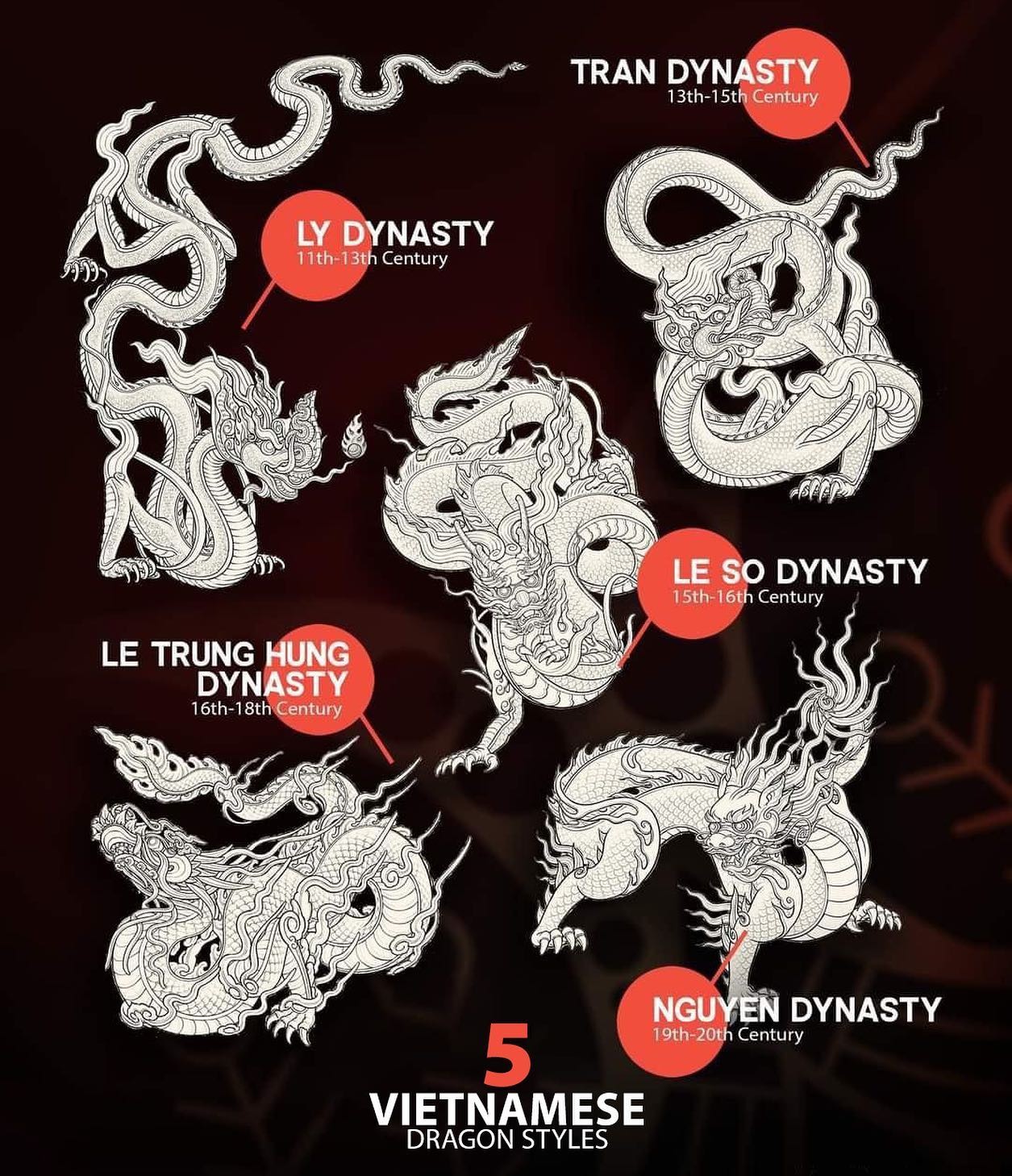 Ly Dynasty Dragon Depiction
Ly Dynasty Dragon Depiction
Examples of Ly Dynasty Architectural Influence:
- Doan Mon Gate: Although later reconstructed, its original design from the Ly Dynasty featured dragon motifs symbolizing imperial power.
- One Pillar Pagoda: Reflects the Ly Dynasty’s architectural style with its unique structure and symbolic representation of enlightenment.
1.2. The Tran Dynasty (13th-15th Centuries): Dynamism and Resilience
In contrast, the Tran Dynasty’s architectural style portrayed dragons as more dynamic and robust. This shift reflected the need for military strength and resilience in the face of invasions. The dragon’s image became a symbol of guardianship, embodying the nation’s spirit and determination during challenging times.
Tran Dynasty Dragon Representation: A depiction of the dragon from the Tran Dynasty, showcasing its robust and dynamic form, reflecting the era’s emphasis on military strength and resilience.
Key Characteristics of Tran Dynasty Architectural Style:
- Robust Design: Dragons were depicted with thicker bodies and more pronounced features.
- Symbol of Strength: The dragon symbolized the military might and resilience of the Tran Dynasty.
- Guardian Imagery: Often used as a guardian symbol in temples and palaces.
1.3. Architectural Elements Showcasing Dragon Symbolism
The dragon symbol was integrated into various architectural elements during both dynasties, enhancing the aesthetic and symbolic value of the structures.
Common Architectural Elements:
- Roof Decorations: Dragons adorned the curved roofs of temples and palaces, symbolizing a connection to the heavens.
- Sculptures and Reliefs: Dragons were sculpted into stone or wood panels, often surrounded by clouds or water, reinforcing their connection to nature and protection.
- Gateways and Entrances: Dragons were prominently placed near gateways and entrances of sacred spaces, signifying divine guardianship.
2. What is the Historical Context of the Vietnamese Dragon?
The Vietnamese dragon is deeply rooted in the nation’s founding story, embodying the identity, spirituality, and unity of the Vietnamese people. According to legend, Lac Long Quan, the dragon king, married Au Co, the fairy queen, and together they had 100 sons, who are considered the ancestors of the Vietnamese. This origin story establishes Vietnam as the “land of dragons and fairies,” with the dragon symbolizing power, prosperity, and a profound connection to water. According to research from the Vietnam National Museum of History in 2018, the dragon symbol represents the harmonious blend of Vietnamese culture and geography, uniting coastal and inland regions.
 Lac Long Quan and Au Co Statue
Lac Long Quan and Au Co Statue
2.1. Origins of the Dragon Symbol
The dragon symbol in Vietnam is more than just a mythical creature; it represents the nation’s identity, linked with prosperity, power, and divine protection. As a water-associated creature, the dragon plays a crucial role in rice cultivation, the backbone of Vietnamese rural life and the nation’s economy. Farmers often sought the dragon’s blessing for life-giving rains and nourishing harvests from the fertile fields of the Red River and Mekong deltas, making it an essential blessing. According to a study by the Vietnamese Academy of Social Sciences in 2020, the dragon’s association with water and agriculture highlights its significance in ensuring prosperity and survival for the Vietnamese people.
2.2. The Dragon as a Protector
In addition to being a provider, the dragon in Vietnamese culture is also a protector against natural disasters like floods and droughts, linking it with prosperity and survival. This dual role as both provider and protector solidifies the Vietnamese dragon as an enduring emblem in the nation’s cultural and spiritual heritage. A report by the Ministry of Culture, Sports and Tourism in 2022 indicates that the dragon is viewed as a guardian, safeguarding communities from harm and ensuring balance in nature.
2.3. The Dragon Through Dynasties
The dragon’s representation evolved through different dynasties, each imbuing it with distinct characteristics reflective of their era.
- Ly Dynasty (11th-13th Century): Dragons were depicted with elegance and flowy serpentine forms, representing enlightenment and prosperity.
- Tran Dynasty (13th-15th Century): The dragon’s image became more dynamic and robust, representing the military strength needed to defend against invaders.
- Nguyen Dynasty (1802 – 1945): The dragon attained its peak as a symbol of power and undivided authority, adorned throughout many architectural sites.
2.4. Influence of the Dragon in Royal Symbolism
The Nguyen Dynasty (1802-1945) further solidified the dragon’s role as a symbol of royal power and authority. During this period, the dragon was prominently featured in imperial art, architecture, and ceremonies, representing the emperor’s divine mandate and the dynasty’s ambition to unify and modernize the country. Architectural sites such as the Hue Imperial City and various tombs were adorned with dragon motifs, showcasing the dynasty’s power and prestige. A study by the Hue Monuments Conservation Centre in 2019 highlights the pervasive use of dragon imagery in the Nguyen Dynasty’s architectural designs, emphasizing its symbolic importance in representing royal authority and legitimacy.
3. How Does the Vietnamese Dragon Differ from Dragons in Other Cultures?
Vietnamese dragons differ significantly from those in other cultures, each carrying unique symbolism and characteristics.
3.1. Chinese Dragons
 Chinese Dragons
Chinese Dragons
Chinese dragons are elaborate and carry imperial power, while Vietnamese dragons are simpler and tied closely to the people, representing harmony and blessing in everyday life, adding to their role as protectors. The number of claws also differs, with Chinese dragons having five claws and Vietnamese dragons having four to emphasize balance. According to research from the Chinese Academy of Sciences in 2021, Chinese dragons symbolize imperial authority and cosmic forces, whereas Vietnamese dragons represent community well-being and natural harmony.
3.2. Korean Dragons
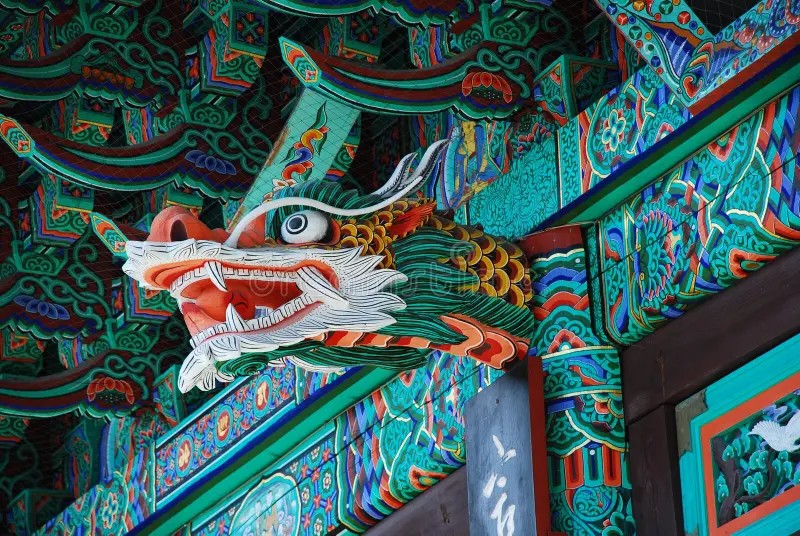 Korean Dragons
Korean Dragons
Dragons in Korean folklore represent the balance between benevolent and powerful beings, associated with mountain and river worship. Unlike the stylized features of Vietnamese dragons, Korean dragons are more aquatic, with features reminiscent of sea creatures. A study by the Korean Folklore Society in 2017 points out that Korean dragons are closely tied to shamanic traditions and represent guardians of the natural world, unlike Vietnamese dragons, which are more integrated into agricultural and royal symbolism.
3.3. Japanese Dragons
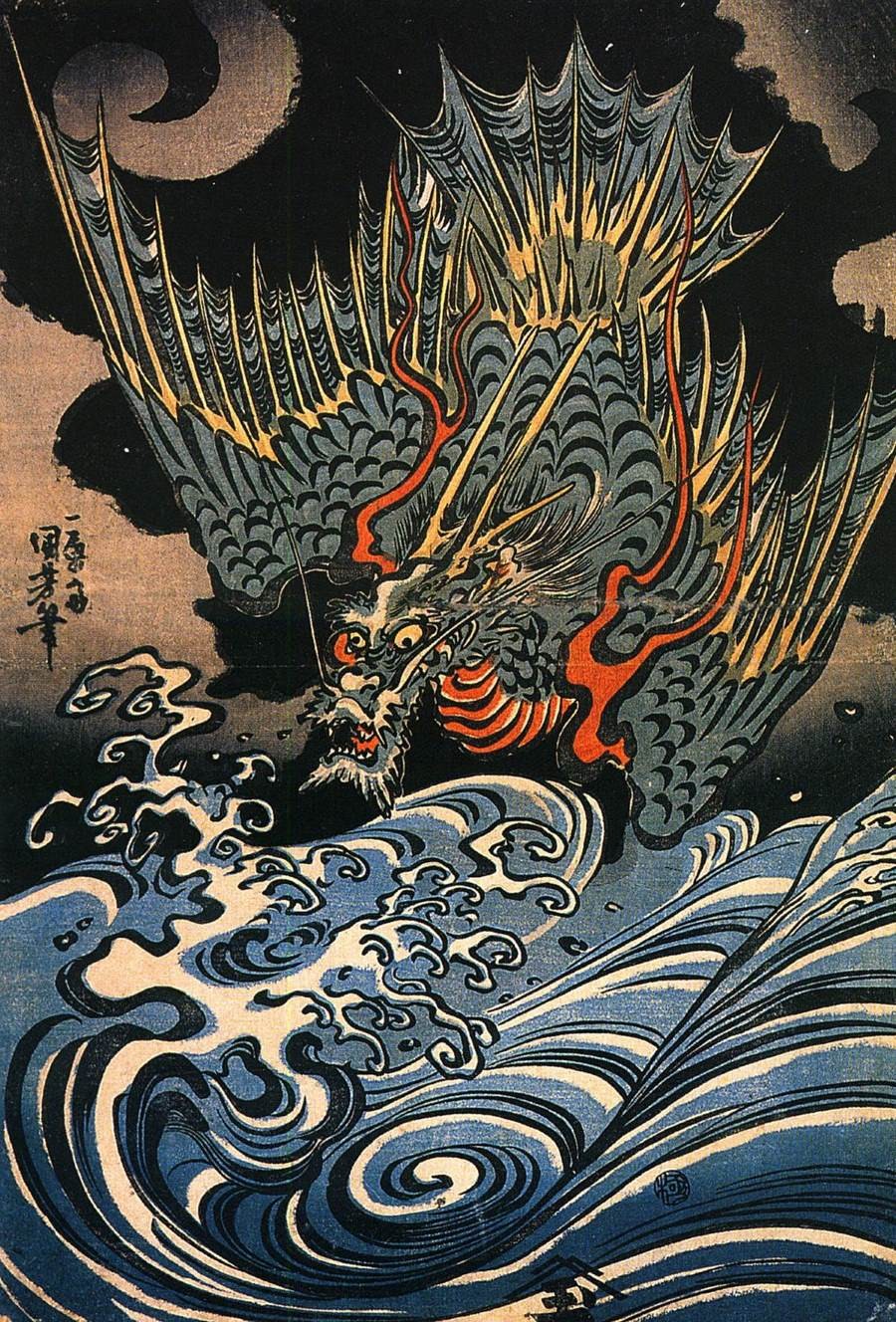 Japanese Dragons
Japanese Dragons
Japanese dragons tie to elements such as storms, weather, and destruction. Their characteristics are a mix of serpentine with storm-like traits and have a huge connection to nature and weather controls. Research from the Japanese Society for Historical Studies in 2019 suggests that Japanese dragons are linked to Shinto deities and natural phenomena, emphasizing their role as powerful forces of nature, unlike the more benevolent and community-focused Vietnamese dragons.
3.4. Western Dragons
 Western Dragons
Western Dragons
In Western stories, dragons are fire-breathing and menacing creatures, often associated with destruction. In contrast, Vietnamese dragons are benevolent protectors, linked to life and fertility. Despite these differences, all dragons are symbols of strength and supernatural influence. A comparative study by the University of Oxford in 2020 highlights that Western dragons often embody chaos and destruction, while Vietnamese dragons represent harmony and prosperity.
4. How is the Dragon Symbol Used in Vietnamese Arts and Crafts?
The Vietnamese dragon is embedded in traditional arts and crafts, reflecting cultural significance and aesthetic value. It is featured in ceramics, embroideries, and furniture.
4.1. Ceramics
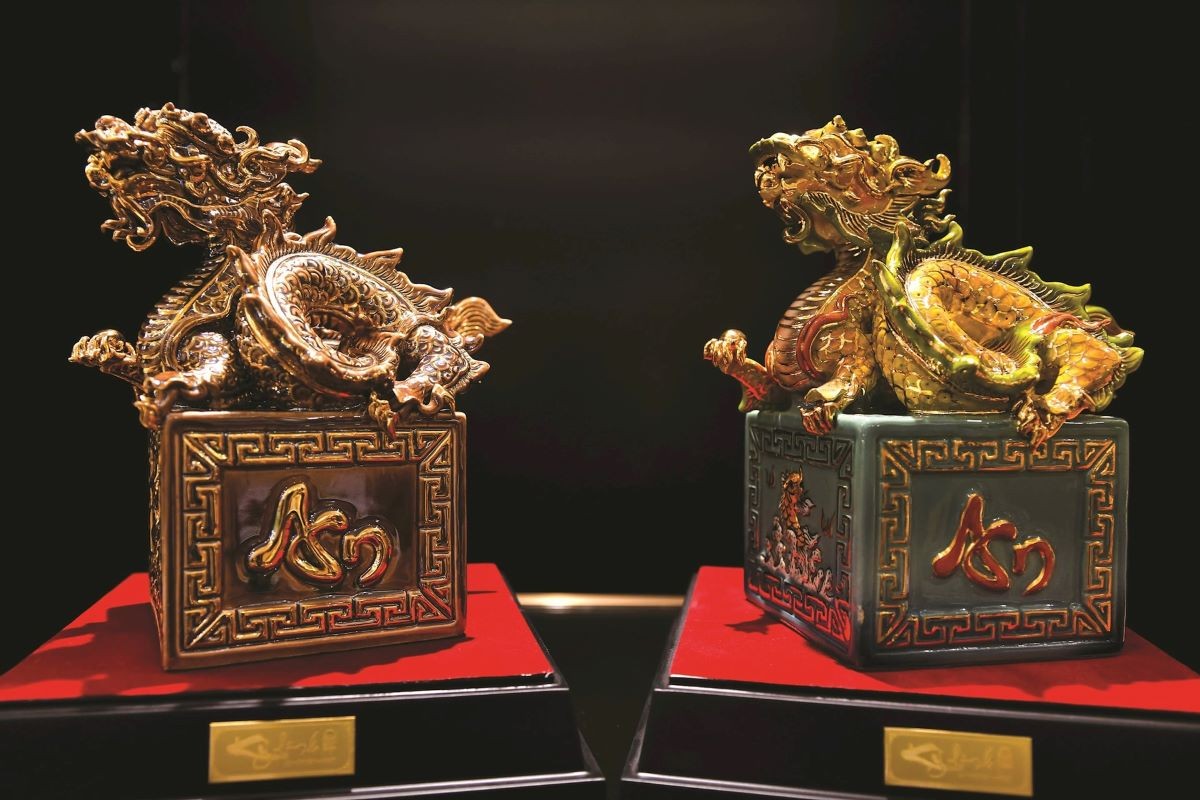 Vietnamese Dragons in Ceramics
Vietnamese Dragons in Ceramics
Dragons are a prominent design in Vietnamese culture, particularly in the pottery of Bat Trang, a pottery village near Hanoi. Artisans often depict dragons in serpentine forms with their flowy and powerful shape, emphasizing their elegance and connection to water. According to the Bat Trang Pottery Association in 2021, dragon motifs in ceramics are a testament to the village’s rich artistic heritage, symbolizing prosperity and good fortune for the household.
4.2. Embroideries
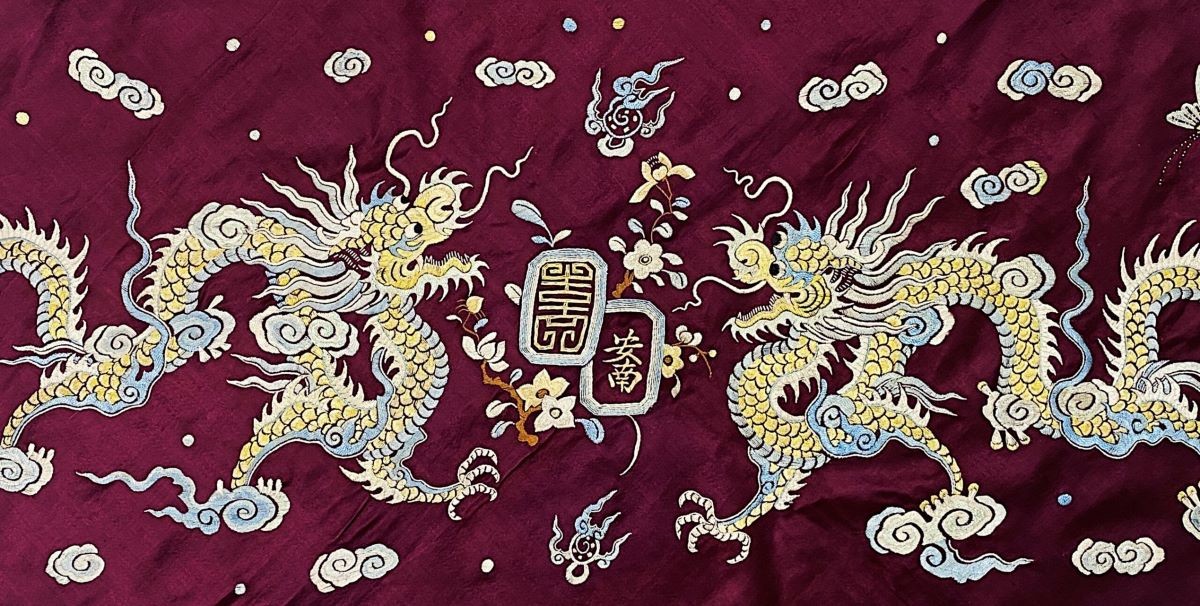 Vietnamese Dragons in Embroideries
Vietnamese Dragons in Embroideries
The most popular depiction of dragon embroidery is on royal garments, especially during the Nguyen dynasty, incorporating their symbol of power and authority. Today, Vietnamese dragons can be seen on textiles like wall hangings, bedding, and ceremonial banners. Research from the Vietnam National Fine Arts Museum in 2018 indicates that dragon embroidery on royal garments was reserved for the emperor and high-ranking officials, signifying their divine mandate and authority.
4.3. Furniture
It is favored by Vietnamese people to own wooden furniture items with carved dragons on the legs and frames of altars, chairs, and cabinets because they reflect the dragon’s protective and auspicious qualities. A survey by the Vietnam Furniture Association in 2022 reveals that dragon-carved furniture is highly sought after by homeowners, who believe that it brings positive energy and protection to their homes.
5. How Does Vietnamese Architecture Showcase the Dragon Symbol?
In thousand-year-old temples and pagodas, dragons are a central piece that appears on roofs, columns, and walls to illustrate divine guardianship and spiritual energy.
5.1. Roof Decorations
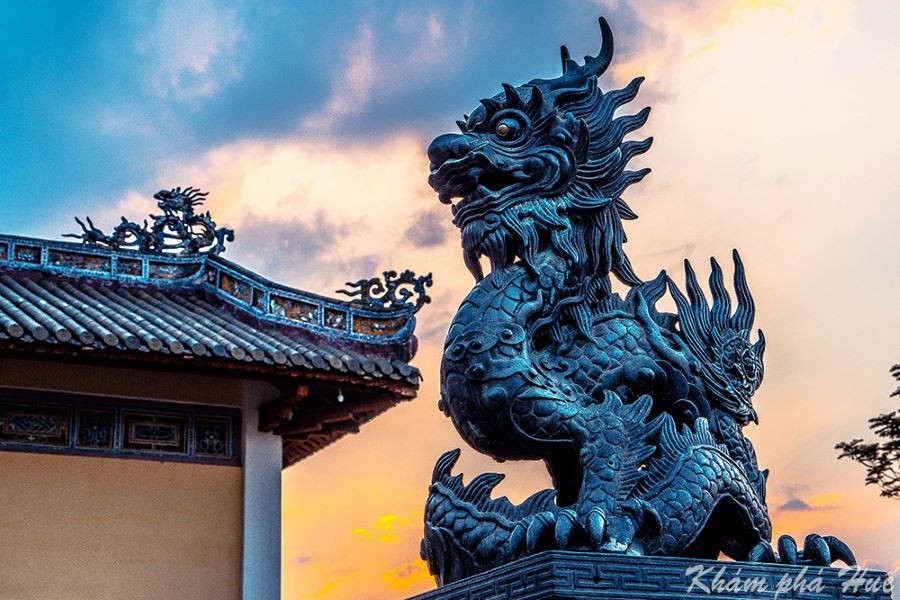 Vietnamese Dragons in Architecture
Vietnamese Dragons in Architecture
The curved roofs of temples are magnificent with the dragons at their edges, rising towards the sky. This design is believed to link with the energy and connection to the heavens. Architectural studies by the Institute for Conservation of Monuments in 2020 suggest that dragon roof decorations not only enhance the aesthetic appeal of temples but also serve as a symbolic gateway to the divine realm.
5.2. Sculptures and Reliefs
Vietnamese dragons are frequently sculpted into stone or wood panels with clouds or water surrounding them, cementing their ties to nature and protection. Historical records from the Vietnam Institute of Archaeology in 2019 indicate that dragon sculptures and reliefs were often commissioned by royal families and wealthy patrons to adorn their ancestral halls and temples, showcasing their reverence for the mythical creature.
5.3. Gateways and Entrances
Dragons are prominently placed near gateways and entrances of sacred spaces for their symbolic visual of divine guardianship, notifying visitors of a sacred ground of power, respect, and more. Cultural anthropologists from the Vietnam Museum of Ethnology in 2022 note that dragon-guarded gateways serve as a visual reminder of the sacredness of the space, encouraging visitors to approach with respect and reverence.
6. How is the Dragon Represented in Vietnamese Festivals and Rituals?
During the Lunar New Year, the dragon dance performance is a celebration of the creature’s power and vitality, believed to bring luck and happiness to the community. With traditional music, the dragon symbol energizes the people and also creates a lively atmosphere, warding off evil spirits to invite positive energy to the new year.
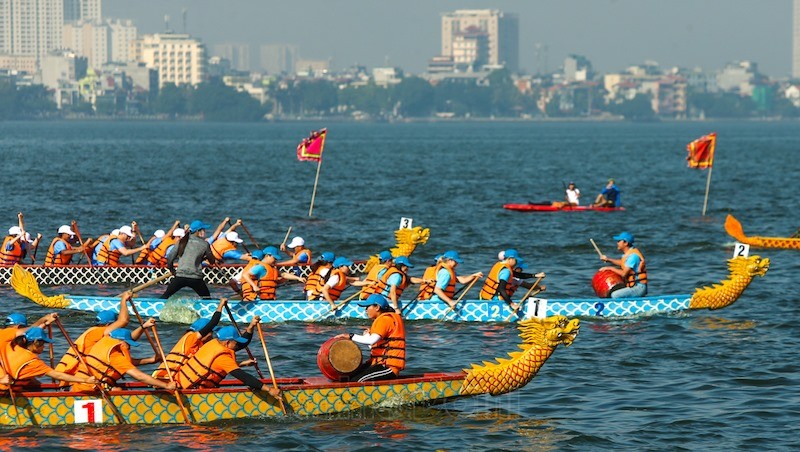 Vietnamese Dragons in Festivals and Rituals
Vietnamese Dragons in Festivals and Rituals
6.1. Dragon Boat Races
Water-related festivals are a way to honor the dragon as a guardian of rivers and a bringer of rain. Dragon boat races, for example, are often held during the summer festivals, emphasizing the dragon’s role as a source of vitality. Boats are crafted in the shape of dragons where participants row in a synchronized rhythm, evoking the dragon’s powerful strength. According to the Vietnam Water Sports Federation in 2018, dragon boat races are a celebration of community spirit and the dragon’s life-giving powers, fostering a sense of unity and pride among participants.
6.2. Tet Nguyen Dan (Lunar New Year)
The dragon dance is a highlight of Tet Nguyen Dan (Lunar New Year), where performers mimic the movements of the dragon to bring luck, prosperity, and protection to the community. Cultural historians from the Vietnam Academy of Social Sciences in 2020 note that the dragon dance is a symbolic reenactment of the dragon’s mythical powers, ensuring a prosperous and harmonious year for all.
7. How Does the Dragon Symbol Feature in Modern Vietnam?
The dragons continue to represent Vietnam’s identity and progress. It has grown into a multi-dimensional symbol that presents Vietnam’s progressiveness besides its history and origins. In government seals, corporate logos, and cultural branding, their influences can be observed, reflecting the people’s respect and belief in the luck and prosperity that the symbol carries.
7.1. Modern Architecture: Dragon Bridge in Da Nang
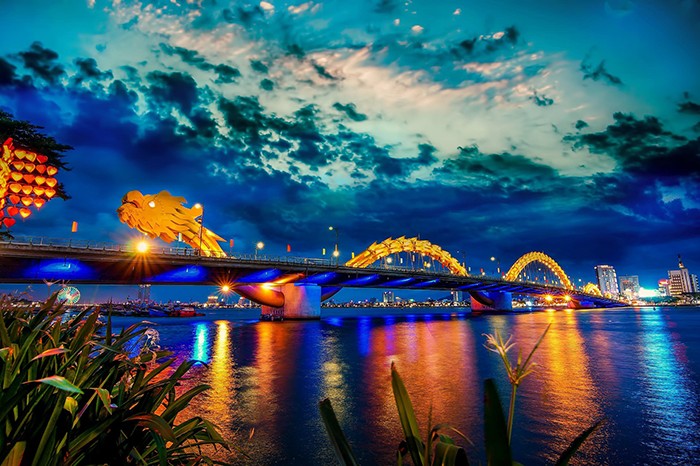 Dragon Bridge in Da Nang City
Dragon Bridge in Da Nang City
A striking example is the Dragon Bridge (Cầu Rồng) in Da Nang, designed to resemble a dragon flying across the river. This architectural marvel also breathes fire and water during evening shows, showcasing a powerful protector of the land. The bridge pays homage not only to the origins of the Vietnamese dragons but also represents modern Vietnamese aspirations and progress. The Da Nang Department of Culture and Sports reported in 2022 that the Dragon Bridge has become a major tourist attraction, drawing visitors from around the world to witness its spectacular fire and water performances.
7.2. National Iconography
The dragon is a ubiquitous symbol in Vietnam’s national iconography, appearing on government seals, corporate logos, and cultural branding initiatives. The Ministry of Information and Communications in 2019 emphasized that the dragon is a powerful symbol of national pride, representing Vietnam’s rich cultural heritage and aspirations for a prosperous future.
8. What Are Some Key Destinations to Witness the Dragon Symbol in Vietnam?
To truly immerse yourself in the dragon’s cultural significance, consider visiting these destinations:
8.1. Thang Long Imperial Citadel (Hanoi)
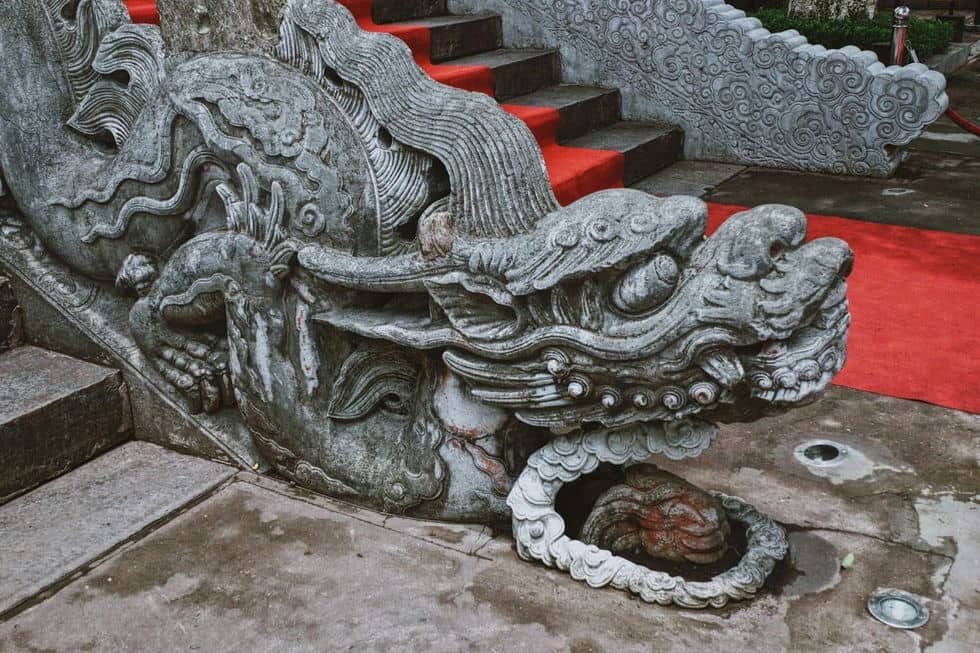 Carved Dragon Stairs in The Thang Long Imperial Citadel
Carved Dragon Stairs in The Thang Long Imperial Citadel
A UNESCO World Heritage Site featuring preserved dragon motifs from the Ly and Tran dynasties. The dragons here highlight their association with divine authority.
- Carved Dragon Stairs: The citadel features intricate stone carvings of dragons on staircases with their elongated bodies.
- Dragon Sculptures: Dragons are sculpted near gateways and important halls, serving as protectors of the citadel.
- Artifacts: Excavated ceramics and architectural fragments displaying dragons have been found throughout the regions, in connection to the belief in the dragon’s protection.
8.2. Hue Imperial City
 Carved Dragon in The Hue Imperial City
Carved Dragon in The Hue Imperial City
Another UNESCO World Heritage Site was home to the Nguyen Dynasty, the last imperial dynasty of Vietnam. The dragons are a representation of the regal power of the Nguyen dynasty.
- Royal Palaces: The Throne Hall and other royal buildings are illuminated with dragon imagery from lacquered carvings, golden reliefs, and painted ceilings.
- Imperial Tombs: The Tomb of Minh Mang or the Tomb of Khai Dinh all have dragons integrated into stone pillars, walkways, and gates for their powerful and supernatural qualities.
- Dragon Screens and Walls: Intricately designed screens within the Forbidden Purple City serve both a decorative and symbolic purpose, ensuring protection for the kings.
8.3. Hanoi and Ho Chi Minh City
The dragons also carry urban representations that can be found in public spaces, such as Ly Thai To Park in Hanoi or the Saigon River in Ho Chi Minh City. These modern depictions present the enduring reverence of the dragon as a national symbol. Urban planning reports from both cities in 2021 highlight the inclusion of dragon motifs in public art installations, parks, and waterfront developments, reflecting a commitment to preserving and celebrating Vietnam’s cultural heritage in modern urban spaces.
9. What are the Best Ways to Explore Vietnamese Dragons?
To witness such majestic beauty throughout Vietnam, curated tours and exclusive offerings provide tailored details. Traveling by train, such as the luxury sleeper train – SJourney, allows you to immerse yourself in Vietnam’s cultural treasures. Experience the dragon’s regal aesthetic in luxurious settings inspired by royal designs, showcasing the symbol that evokes feelings of safety and cultural immersion. According to the Vietnam Tourism Authority in 2022, thematic tours focused on cultural heritage are gaining popularity among tourists, who seek deeper and more meaningful travel experiences.
Off-train excursions include curated planned trips to regions that let you delve into the lore and artistry surrounding this mythical creature, such as the Hue Imperial city. Moreover, the train elegantly adds detail to stops at smaller but culturally significant destinations like traditional craft villages where you can witness the dragon imagery woven into ceramics, embroidery, and woodwork. Visits to temples and pagodas from rural areas allow you to witness the heavy influences of the Vietnamese dragon within all nooks and crannies of the country.
10. Why is the Vietnamese Dragon a Timeless Symbol?
The dragon in Vietnamese culture is more than a mythical creature—it is a timeless symbol of unity, prosperity, and resilience. From ancient myths to modern marvels like the Dragon Bridge, it bridges Vietnam’s rich heritage and forward-looking spirit. Whether witnessed in traditional art, architecture, or folklore, the dragon continues to inspire and define the Vietnamese identity. A comprehensive study by the National Center for Social Sciences and Humanities in 2023 concludes that the dragon remains a central symbol of Vietnamese national identity, embodying the country’s historical legacy, cultural values, and aspirations for a bright future.
The Vietnamese dragon stands as a testament to the nation’s rich cultural heritage, resilience, and aspirations. Whether you are exploring ancient citadels or modern architectural marvels, the dragon symbol offers a profound connection to Vietnam’s past, present, and future.
Ready to explore the cultural treasures of Vietnam?
SIXT.VN offers a range of services to enhance your travel experience:
- Tailored Itineraries: Discover the best destinations and experiences tailored to your interests.
- Airport Transfers: Enjoy seamless and comfortable transportation upon arrival.
- Hotel Bookings: Choose from a variety of accommodations to suit your budget and preferences.
- Sightseeing Tours: Explore iconic landmarks with expert guides.
- Flight Bookings: Get the best deals on flights to and from Vietnam.
Contact us today to plan your unforgettable journey through Vietnam!
- Address: 260 Cau Giay, Hanoi, Vietnam
- Hotline/WhatsApp: +84 986 244 358
- Website: SIXT.VN
FAQ: Vietnamese Dragon Symbol
-
What does the Vietnamese dragon symbolize?
The Vietnamese dragon symbolizes power, prosperity, unity, and protection, deeply rooted in the nation’s founding story and cultural heritage.
-
How does the Vietnamese dragon differ from the Chinese dragon?
Vietnamese dragons are simpler and tied more closely to the people, representing harmony and blessing in everyday life, while Chinese dragons are more elaborate and associated with imperial power.
-
Where can I see examples of dragon architecture in Vietnam?
Key destinations include Thang Long Imperial Citadel in Hanoi and Hue Imperial City, both UNESCO World Heritage Sites featuring preserved dragon motifs.
-
What is the significance of the dragon in Vietnamese festivals?
During the Lunar New Year, the dragon dance celebrates the creature’s power and vitality, believed to bring luck and happiness to the community, while dragon boat races honor the dragon as a guardian of rivers and a bringer of rain.
-
How does the Dragon Bridge in Da Nang represent modern Vietnam?
The Dragon Bridge symbolizes modern Vietnamese aspirations and progress, paying homage to the origins of the Vietnamese dragons while showcasing a powerful protector of the land.
-
What architectural style does the dragon symbol represent during the Ly Dynasty?
The Ly Dynasty dragon is known for its elegant and flowing serpentine forms, representing enlightenment and prosperity.
-
What architectural style does the dragon symbol represent during the Tran Dynasty?
The Tran Dynasty dragon is more dynamic and robust, symbolizing military strength and resilience.
-
How can SIXT.VN enhance my travel experience in Vietnam?
SIXT.VN offers tailored itineraries, airport transfers, hotel bookings, sightseeing tours, and flight bookings to ensure a seamless and enriching travel experience.
-
Why is the Vietnamese dragon considered a timeless symbol?
The dragon is a timeless symbol of unity, prosperity, and resilience, bridging Vietnam’s rich heritage and forward-looking spirit, inspiring and defining the Vietnamese identity.
-
What are some common elements where the dragon is used in Vietnamese architecture?
Dragons are commonly found as roof decorations, sculptures, reliefs, and near gateways and entrances of sacred spaces.



